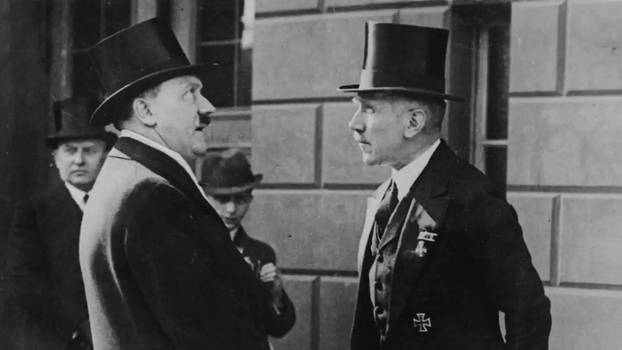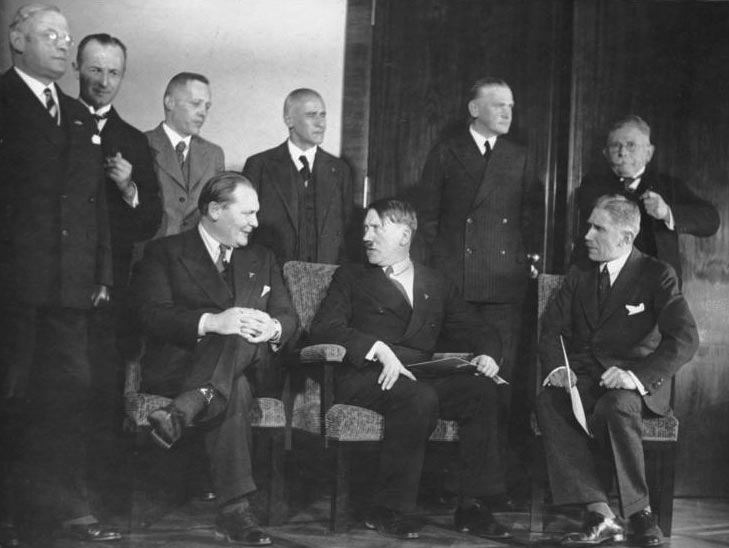
On 30 January 1933, Adolf Hitler was appointed German chancellor. While the workers’ parties were mired in in-fighting, the traditional elites of the German Reich helped Hitler to power—with the active support of many industrialists, as well as the bourgeois “parties of the centre”. Albert Scharenberg analyses the political stance taken by the bourgeoisie at the time, and why we ought to reconsider its role today.
The extent to which the Social Democratic Party (SPD) and the Communist Party of Germany (KPD) deserve a portion of the blame for the transfer of power to Hitler on 30 January 1933 has often been a subject of debate, and rightly so. The two major workers’ parties had been bitterly opposed to one another since the First World War and the German Revolution of 1918–19, during which they found themselves on opposite sides of the barricades. A steady and reciprocal flow of denunciations and antagonism followed. Many Social Democrats promulgated the theory that Communists and National Socialists had a common “totalitarian” mindset, while the Communist International declared the Social Democrats “social fascists” who were ultimately even more dangerous than Mussolini and Hitler. This made it impossible to constitute a “united front” against National Socialist fascism, as was being called for by the more far-sighted activists—particularly from minor parties like the SAP and the KPO, which had split from the SPD and the KPD for precisely this reason. The end result was that Hitler had little trouble putting the political left out of action.
Albert Scharenberg works as the director of the Rosa-Luxemburg-Stiftung’s Historical Centre. Translation by Sam Langer and Joel Scott for Gegensatz Translation Collective.
However, neither the SPD nor the KPD ever actively supported Hitler’s accession to power or his rule. On the contrary: the Communists, who were among the first victims of the Nazi dictatorship, and the Social Democrats, who as late as 24 March 1933 refused to vote for the “Enabling Act” (Ermächtigungsgesetz) in the Reichstag, would soon find themselves reunited in the concentration camps. Many of those who were not immediately interned went into active resistance against the dictatorship. In short, the SPD and the KPD committed serious political errors, but they cannot be blamed for actively contributing to Hitler’s accession to power, nor for helping to consolidate the dictatorship.
The Role of the Traditional Upper Classes
The old elites were an entirely different matter. The Empire’s traditional upper classes—from the military, the judiciary, the civil service, and education—had kept their high-ranking offices thanks to the aborted revolution of 1918–19, and were openly hostile to the new Republic. This cohort was literally indispensable for the transfer of power to Hitler and for the consolidation of fascist rule. This pertains, firstly, to their political representatives, the monarchist and anti-Semitic German National People’s Party (Deutschnationale Volkspartei, DNVP), which supported Hitler’s appointment as chancellor and provided Hitler’s government with its electoral majority; and secondly, to the then-President of Germany and former imperial Generalfeldmarschall, Paul von Hindenburg. Contrary to a political legend maintained by those whose interests it serves, there is no evidence to support the notion of a “seizure of power” (Machtergreifung) by Hitler. In reality, after the failed Putsch of 1923, Hitler and the Nazi Party were neither willing nor able to “seize” power in any way (notwithstanding the paramilitary brown-shirts of the Sturmabteilung), but rather sought to reach it through “legal” channels, that is to say: power had to be transferred to them, by the President of Germany. Hindenberg may well have hesitated to appoint Hitler chancellor—but ultimately, that is precisely what he did. And as the leading representative of the Empire’s old elite, he also failed to change his stance in the face of the increasingly brutal dictatorship.
It was nevertheless not only the support of the old, mainly monarchist elites that helped Hitler gain power and consolidate his rule. The bourgeoisie also played a decisive role.
Corporate Backers
First and foremost, there was the support Hitler received from the business world. The strength of the support from this camp during the rise of the Nazi Party between 1928 and 1932 is a topic of discussion in the academic literature. What is nonetheless certain is that this pre-existing, substantial support increased sharply during the months immediately prior to the transfer of power. And this was no coincidence. For a long time, many industrialists had been expressing more reservations about the Nazi Party’s putative “socialism” than about its overt anti-Semitism. The situation came to a head in November 1932. On 6 November, the Nazi Party’s vote declined by more than four percent in the Reichstag elections, while the KPD was able to make significant gains. The fascist party seemed to have passed its electoral zenith, and was even on the verge of splitting in the weeks that followed. It was at this point that the mood among the business community swung decisively in Hitler’s favour. The fact that Hitler openly expounded his programme to business leaders in internal discussions, declaring his intention to rapidly remove Social Democrats, Communists, and Jews from all leadership positions in Germany, did not detract from their approval at all – on the contrary.
A significant index of corporate support was the so-called Industrielleneingabe (Industrialists’ Petition) sent to Hindenburg on 19 November 1932 by industry representatives, bankers, and major agriculturalists—including the former (and later) president of the Reichsbank, Hjalmar Schacht, business magnate Fritz Thyssen, and Eberhard Graf von Kalkreuth, president of the Imperial Agricultural League. In this letter, they demanded Hitler’s appointment as chancellor, which they describe as “the propitious commencement of an era that, through the overcoming of class antagonisms, will create the vital basis for a resurgence of the German economy.”
Even though Reinhard Neebe’s 1981 book, Großindustrie, Staat und NSDAP 1930–1933 rightly questions the decisive role that some Marxist historians attribute to this petition, it remains an exceedingly noteworthy document—which, moreover, marked only the beginning of the growing support Hitler came to enjoy in the corporate world. In the following weeks, ever more business representatives declared their support for Hitler, often with a mention of the KPD’s then best-ever election results (16.9 percent, corresponding to 100 representatives in the Reichstag). Representatives of capital also played a decisive role in mediating talks between Hitler and Franz von Papen in January 1933, which laid the ground for the formation of an NSDAP-DNVP coalition government.
Once power was transferred to Hitler, there was no more stopping this trend. Despite—or perhaps because of—the fact Hitler’s speeches to industry representatives in February 1933 left no room for doubt concerning the dictatorial, expansionist nature of his programme, political and financial support for the Nazi Party went through the roof. We can say that by 30 January at the latest, a majority of the big industrialists were backing Hitler.
The Tragedy of the Bourgeois Parties
In addition to this support from large sectors of the bourgeoisie, there is the tragedy that was staged by the bourgeoisie’s political representatives. Prior to 30 January, the bourgeois parties—the Centre Party, the Bavarian People’s Party, the German State Party, and assorted minor parties—had already contributed to the rise of the Nazi Party with their failed attempts to combat the economic crisis. The high point of their failure, however, came in the weeks immediately after Hitler’s government took office. All illusions about von Papen helping to “integrate” the Nazis rapidly fell away, as Hitler wasted no time transforming German democracy into a dictatorship. On 4 February the “Decree of the Reich President for the Protection of the German People” massively restricted freedom of assembly and the freedom of the press, and on 28 February, one day after the Reichstag fire, the “Decree of the Reich President for the Protection of the People and the State” suspended fundamental rights. The persecution of Communists, including members of parliament, also began immediately after 30 January.
Yet barely a word of protest was heard from the bourgeois parties. On the contrary. After a new round of national elections on 5 March—in which the Nazi Party fell well short of an absolute majority, despite massive electoral manipulation in the lead-up—Hitler finally tabled a “Law to Remedy the Distress of People and Reich”, the so-called Enabling Act, stipulating that the government could pass laws without parliamentary approval even if they deviated from the constitution. The political representatives of the bourgeoisie were now decisive, since a two-thirds majority was required to pass the act; a majority that was in no way guaranteed, despite the fact that all representatives from the KPD and a number from the SPD had been arrested or fled. But while the remaining SPD representatives unanimously voted against the Enabling Act, there was not a single vote against the Act from the Centre Party, the Bavarian People’s Party, or the German State Party (whose delegates included Theodor Heuss, the later President of the Federal Republic). They all voted for the self-abolition of democracy and the establishment of the Nazi dictatorship.
Just one week later, on 1 April, the Nazi Party organized a boycott of Jewish businesses; and the following week, the cabinet passed the “Law for the Restoration of the Professional Civil Service”, the purpose of which was to remove Jews and political opponents from positions in the civil service.
The centre had completely failed to defend democracy. In other words: the Weimar Republic was not destroyed by “extremists from the right and the left”. Rather, its grave was dug by Nazi fascists and the old elites, and the support that these groups received from large sections of the bourgeoisie—support which was initially crucial for the consolidation of Nazi rule. Today’s “parties of the centre” should keep these facts in mind when confronting the rise of the radical right in Germany and Europe.
